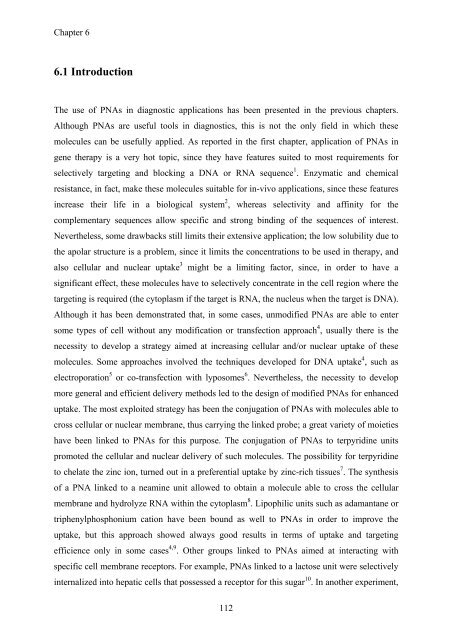View - DSpace UniPR
View - DSpace UniPR
View - DSpace UniPR
You also want an ePaper? Increase the reach of your titles
YUMPU automatically turns print PDFs into web optimized ePapers that Google loves.
Chapter 6<br />
6.1 Introduction<br />
The use of PNAs in diagnostic applications has been presented in the previous chapters.<br />
Although PNAs are useful tools in diagnostics, this is not the only field in which these<br />
molecules can be usefully applied. As reported in the first chapter, application of PNAs in<br />
gene therapy is a very hot topic, since they have features suited to most requirements for<br />
selectively targeting and blocking a DNA or RNA sequence 1 . Enzymatic and chemical<br />
resistance, in fact, make these molecules suitable for in-vivo applications, since these features<br />
increase their life in a biological system 2 , whereas selectivity and affinity for the<br />
complementary sequences allow specific and strong binding of the sequences of interest.<br />
Nevertheless, some drawbacks still limits their extensive application; the low solubility due to<br />
the apolar structure is a problem, since it limits the concentrations to be used in therapy, and<br />
also cellular and nuclear uptake 3 might be a limiting factor, since, in order to have a<br />
significant effect, these molecules have to selectively concentrate in the cell region where the<br />
targeting is required (the cytoplasm if the target is RNA, the nucleus when the target is DNA).<br />
Although it has been demonstrated that, in some cases, unmodified PNAs are able to enter<br />
some types of cell without any modification or transfection approach 4 , usually there is the<br />
necessity to develop a strategy aimed at increasing cellular and/or nuclear uptake of these<br />
molecules. Some approaches involved the techniques developed for DNA uptake 4 , such as<br />
electroporation 5 or co-transfection with lyposomes 6 . Nevertheless, the necessity to develop<br />
more general and efficient delivery methods led to the design of modified PNAs for enhanced<br />
uptake. The most exploited strategy has been the conjugation of PNAs with molecules able to<br />
cross cellular or nuclear membrane, thus carrying the linked probe; a great variety of moieties<br />
have been linked to PNAs for this purpose. The conjugation of PNAs to terpyridine units<br />
promoted the cellular and nuclear delivery of such molecules. The possibility for terpyridine<br />
to chelate the zinc ion, turned out in a preferential uptake by zinc-rich tissues 7 . The synthesis<br />
of a PNA linked to a neamine unit allowed to obtain a molecule able to cross the cellular<br />
membrane and hydrolyze RNA within the cytoplasm 8 . Lipophilic units such as adamantane or<br />
triphenylphosphonium cation have been bound as well to PNAs in order to improve the<br />
uptake, but this approach showed always good results in terms of uptake and targeting<br />
efficience only in some cases 4,9 . Other groups linked to PNAs aimed at interacting with<br />
specific cell membrane receptors. For example, PNAs linked to a lactose unit were selectively<br />
internalized into hepatic cells that possessed a receptor for this sugar 10 . In another experiment,<br />
112
















